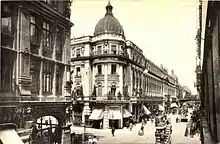Hermann von der Hude
Hermann Philipp Wilhelm von der Hude (2 June 1830 in Lübeck – 4 June 1908 in Berlin) was a German architect.
Hermann Philipp Wilhelm von der Hude | |
|---|---|
 | |
| Occupation | Architect |

Hotel-Central, Berlin, 1881 (destroyed 1945)
von der Hude trained under the Berlin architect Friedrich August Stüler. In 1860 he formed a long-lasting partnership with Julius Hennicke (1832 - 1892). Both had trained at the Berlin Bauakademie under Stüler and Friedrich Ludwig Persius, putting them firmly in the direct influence of Karl Friedrich Schinkel and the "Schinkel school".
Latvian architect Karl Felsko worked for von der Hude and Hennicke in the 1860s.
Work
von der Hude's work includes:
- Kunsthalle Hamburg, with Georg Theodor Schirrmacher, Hamburg, 1863-69
- reconstruction, Palais am Festungsgraben, with Georg Heinrich Bürde, Berlin, 1863-64
- Hotel Kaiserhof, with Julius Hennicke, Berlin, 1875 (destroyed 1945)[1]
- Hotel Central, with Hennicke, Berlin, 1880-81 (destroyed 1945)
- reconstruction of the prayer hall at Neue Kirche, Berlin, with Hennicke, according to plans from Johann Wilhelm Schwedler, 1881-82
- Gera Hauptbahnhof, with Hennicke, 1881 (disfigured circa 1960)
- Davidsonska Palace, with Swedish architect Magnus Isæus, Stockholm, 1881 (destroyed 1942)
- Lessing Theater, Berlin, with Hennicke, 1887-88 (destroyed 1945)[2]
References
- Martin Gropius: Leben und Werk eines Berliner Architekten 1824-1880, by Arnold Körte, page 455
- American Architect and Architecture, May 12, 1894, Volume 44, page 59-60
| Wikimedia Commons has media related to Hermann von der Hude. |
| Wikimedia Commons has media related to Von der Hude & Hennicke. |
This article is issued from Wikipedia. The text is licensed under Creative Commons - Attribution - Sharealike. Additional terms may apply for the media files.